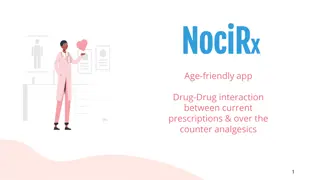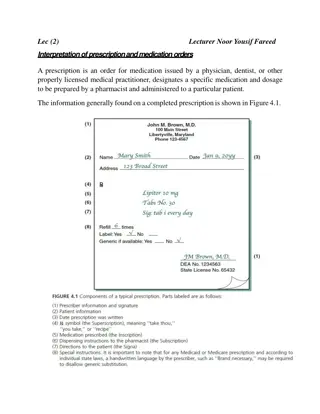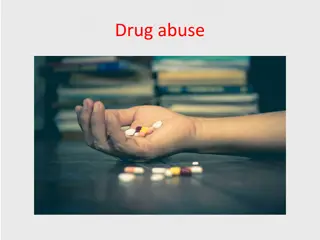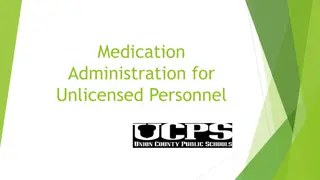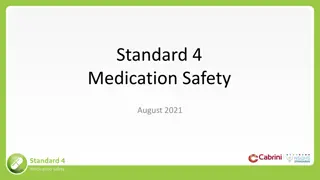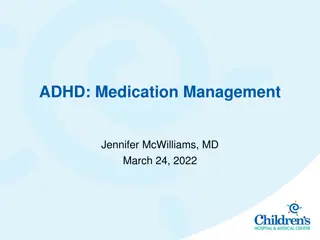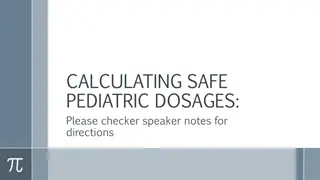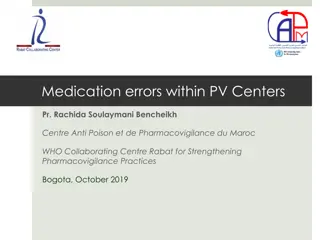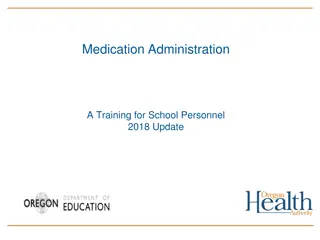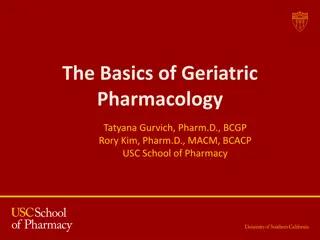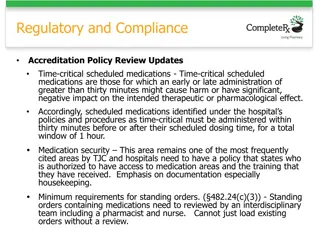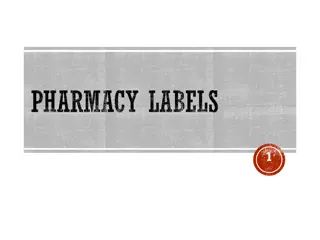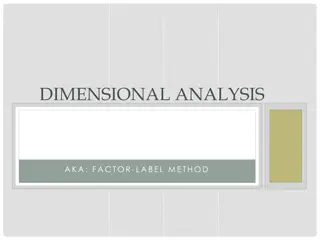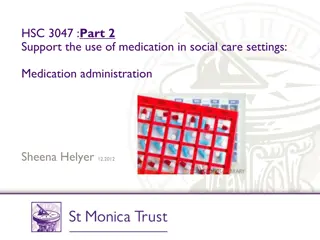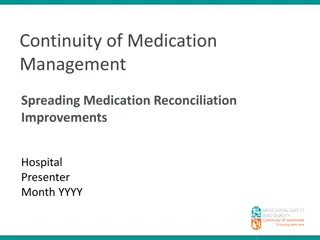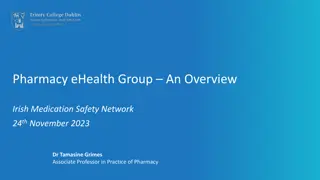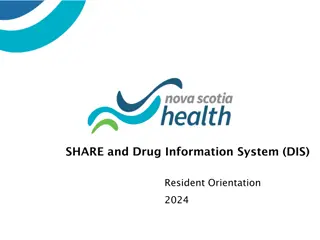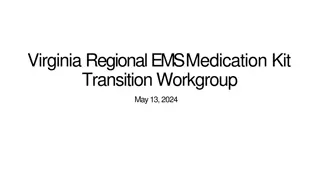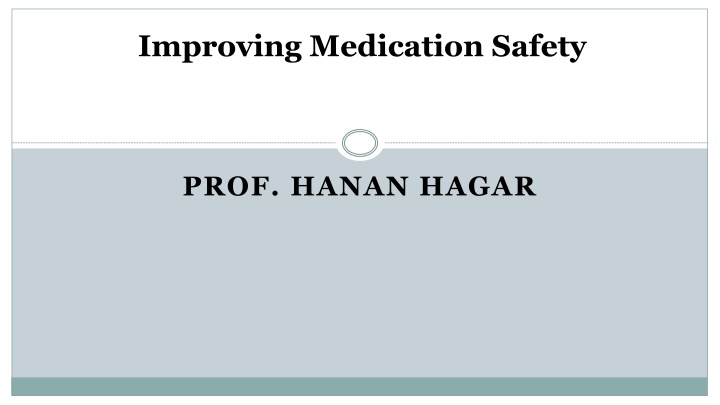
Medication Errors and Improving Safety Practices
Explore the world of medication safety with a focus on understanding medication errors, identifying factors contributing to errors, and learning ways to enhance medication safety practices. Gain insights into the prevalence of medication errors, their potential consequences, and the importance of a multidisciplinary approach to promoting safer medication use in healthcare settings.
Download Presentation

Please find below an Image/Link to download the presentation.
The content on the website is provided AS IS for your information and personal use only. It may not be sold, licensed, or shared on other websites without obtaining consent from the author. If you encounter any issues during the download, it is possible that the publisher has removed the file from their server.
You are allowed to download the files provided on this website for personal or commercial use, subject to the condition that they are used lawfully. All files are the property of their respective owners.
The content on the website is provided AS IS for your information and personal use only. It may not be sold, licensed, or shared on other websites without obtaining consent from the author.
E N D
Presentation Transcript
Improving Medication Safety PROF. HANAN HAGAR
Learning objectives To provide an overview of Medication Safety To encourage students to learn and practice ways to improve the safety of medication use
Knowledge requirements Understand the scale of medication error Understand the steps involved in a patient using medication Identify factors that contribute to medication error Learn how to make medication use safer Understand the benefits of a multidisciplinary approach to medication safety
Medication Error Medication use has become increasingly complex in recent times Medication errors are a major cause of preventable patient harm As future health-care workers, you will have an important role in making medication use safe.
Medication Errors The drugs errors are the most common cause of medical errors in hospitals, affecting 3.7% of patients.
Definitions Medication Error: is any preventable event that may cause or led to inappropriate medication use or patient harm. Medication error may result in An adverse event if a patient is harmed A near miss if a patient is nearly harmed.
Definitions Side effect of a drug: a known effect, other than that primarily intended, relating to the pharmacological properties of a medication e.g. opiate analgesia often causes nausea. Adverse reaction of a drug: unexpected harm arising from a justified action where the correct Process was followed for the context in which the event occurred e.g. An unexpected allergic reaction in a patient taking a medication for the First time.
Definitions Adverse drug event: an incident in which a patient is harmed. It includes both errors & side effects of the medication. Adverse drug event: May be preventable (e.g. the result of an error) or May not be preventable (e.g. the result of an adverse drug reaction or side-effect)
Categorizing Medication Errors 2001 National Coordinating Council for Medication Error Reporting and Prevention.
Steps in using medication Prescribing Preparation and Dispensing Administration Monitoring Note: these steps may be carried out by healthcare workers or the patient; e.g. self-prescribing over the counter medication and self Administering medication at home.
Medication Prescription Choosing an appropriate medication for a given clinical situation, taking individual patient factors into account, such as allergies Selecting the administration route, dose, time and regimen Documentation Communicating details of the plan with: Whoever will administer the medication (written-transcribing and/or verbal) and the patient
Sources of error in prescribing: Inadequate knowledge about drug indications an contraindications Not considering individual patient factors such as allergies, pregnancy, co-morbidities, other medications Wrong patient, wrong dose, wrong time, wrong drug, wrong route Mathematical error when calculating dosage Documentation: incomplete, ambiguous & dangerous abbreviation Inadequate communication (written, verbal) Incorrect data entry when using computerized prescribing e.g. duplication, omission, wrong number
Example for prescribing error Illegible Handwriting
Strategies to Reduce Prescribing errors Avoid illegible handwriting Write complete Information Look at Patient-Specific Information Do Not Use Abbreviations Decimals Be alert to drug name, use generic name rather than trade names Write the Medication reconciliation Know the high alert medications More attention to dosage calculations Verbal orders
Strategies to Reduce Prescribing errors Write complete Information Patient s Name Patient-Specific Data Generic and Brand Name Drug Strength Dosage Form Amount Directions for Use Purpose Refills Avoid illegible handwriting Write/Print More Carefully Use Computers Verbal Communications
Strategies to Reduce Prescribing errors Do Not Use Abbreviations Drug names QD or OD for the word daily Letter U for unit g for microgram (use mcg) QOD for every other day Look at Patient-Specific Information Age Weight Renal and Hepatic Function Laboratory Test Results Concurrent Medications Allergies Medical/Surgical/Family History Pregnancy/Lactation Status
Strategies to Reduce Prescribing errors Decimals: Avoid whenever possible Use 500 mg for 0.5 g Use 125 mcg for 0.125 mg Never leave a decimal point naked Haldol .5 mg Haldol 0.5 mg Never use a terminal zero Colchicine 1 mg not 1.0 mg Space between name and dose Inderal40 mg Inderal 40 mg Be alert to Drug Name: Look-Alike or Sound-Alike Drug Names Celebrex (celecoxib, anti-inflammatory) Cerebryx (fosphenytoin, anticonvulsant) Celexa (Citalpram, antidepressant)
How can medication presentation contribute to medication errors? LOOK-ALIKE, SOUND-ALIKE MEDICATIONS AMBIGUOUS LABELING
Look-a-like and sound-a-like medications Celebrex (an anti-inflammatory) Cerebryx (an anticonvulsant) Celexa (an antidepressant)
Ambiguous nomenclature Tegretol 100mg S/C 1.0 mg .1 mg Tegreto 1100 mg S/L 10 mg 1 mg
Avoiding ambiguous nomenclature avoid trailing zeros e.g. write 1 not 1.0 use leading zeros e.g. write 0.1 not .1 know accepted local terminology write neatly, print if necessary
Strategies to Reduce Prescribing errors Write the Medication reconciliation Learn and practice thorough medication history taking: Include name, dose, route, frequency duration of every drug the patient is taking; Enquire about recently ceased medications; Ask about over-the-counter medications dietary supplements and complimentary medicines; More Attention to dosage calculations: Use patient specific information height weight age body system function
Strategies to Reduce Prescribing errors Know the high alert medications Need double check Example : Oral anticoagulants Insulin Chemotherapeutic agents Neuromuscular blocking agents Concentrated electrolytes Emergency medications (potent and used in high pressure situations) Verbal Orders: Avoid when possible Pronounce slowly and distinctly State numbers like pilots (i.e., one-five mg for 15 mg) Spell out difficult drug names Specify concentrations
Strategies to Reduce Dispensing Errors Standardized concentrations for all IV medication Use commercially prepared solutions Dispense a unit of use.
Administration Obtaining the medication in a ready-to-use form; may involve counting, calculating, mixing, labeling or preparing in some way. Checking for allergies Giving the right medication to the right patient, in the right dose, via the right route, at the right time. Documentation
How can drug administration go wrong? Wrong patient Wrong route Wrong time Wrong dose Wrong drug Omission, failure to administer Inadequate documentation
The 5 Rs Right Patient Right Drug Right Dose Right Route Right Time
Remember the 5 Rs when prescribing and administering 1. Right Patient (check the name in the order & the patient, use two identifier & ask the patient to identify himself/herself). 2. Right Medication (check the medication label & order). 3. Right Route (Confirm that the patient can take or receive the medication by the ordered route) 4. Right Time (Check the frequency of the ordered medication & Confirm when the last dose was given). 5. Right Dose (Confirm appropriateness of the dose using a current drug reference & correct calculation)
Strategies to Reduce Administration Errors Be familiar with the institution policy Preprinted & standardized infusion rate charts Use programmable infusion device Infusion tubing should be traced from the infusion bag to the point of delivery
Calculation errors Can you answer the following question? A patient needs 300 micrograms of a medication that comes in a 1 ml ampoule containing 1 mg of the drug. What volume do you draw up and inject?
Calculation errors Can you answer the following question? A 12 kg, 2-year-old boy requires 15 mg/kg of a medication that comes as a syrup with a concentration of 120mg/5mls. How many mls do you prescribe?
Medication monitoring Monitoring involves Observing the patient to determine if the medication is working, being used appropriately and not harming the Patient. Documentation
How can monitoring go wrong? Lack of monitoring for side-effects Drug not ceased if not working, or course completed Drug ceased before course completed Drug levels not measured, or measured but not checked or acted upon. Communication failures: this is a risk if the care provider changes, for example, if the patient moves from the hospital setting to the Community setting or vice versa
Do you know which drugs need blood tests to monitor levels? ?
Which patients are most at risk of medication errors ? Patients on multiple medications Patients with another condition e.g. renal impairment, pregnancy Patients who cannot communicate well Patients who have more than one doctor Children and babies (dose calculations required?)
Factors for Medication Errors Staff Factors Inexperience Rushing Doing two things at the same time Interruptions Fatigue, boredom, or stress Lack of checking and double checking habits Poor teamwork and/or communication between colleagues
How can workplace design contribute to medication errors? Absence of a safety culture in the workplace e.g. poor reporting systems and failure to learn from past near misses and adverse events Inadequate staff numbers Absence of memory aids for staff
Ways to make medication use safer Use generic names where appropriate Tailor prescribing for individual patients Learn and practice collecting complete medication histories Know the high-risk medications and take precautions Be very familiar with the medications you prescribe Use memory aids Remember the 5 Rs when prescribing and administering Communicate clearly Develop checking habits Encourage patients to be actively involved Report and learn from errors
Recommended actions Pharmacists/Technician should READ / CHECK carefully the label of each medication they prepare. DOUBLE CHECKING is essential tool to avoid such mistakes Look Alike medications should be stored separately with proper labeling to avoid such mistakes
Case Study - 2 A 38-year-old woman comes to the hospital with 20 minutes of itchy red rash and facial swelling; she has a history of serious allergic reactions A nurse draws up 10 mls of 1:10,000 adrenaline (epinephrine) into a 10 ml syringe and leaves it at the bedside ready to use (1 mg in total) just in case the doctor requests it Meanwhile the doctor inserts an intravenous cannula The doctor sees the 10 ml syringe of clear fluid that the nurse has drawn up and assumes it is normal saline
Continue There is no communication between the doctor and the nurse at this time The doctor gives all 10 mls of adrenaline (epinephrine)through the intravenous cannula thinking he is using saline to flush the line. The patient suddenly feels terrible, anxious, becomes tachycardia and then becomes unconscious with no pulse She is discovered to be in ventricular tachycardia, is resuscitated and fortunately makes a good recovery Recommended dose of adrenaline (epinephrine) in anaphylaxis is 0.3 - 0.5 mg IM, this patient received 1mg IV
Can you identify the contributing factors to this error?
Answer Assumptions Lack of communication Inadequate labeling of syringe Giving a substance without checking and double checking what it is Lack of care with a potent medication
How could this error have been prevented? Never give a medication unless you are sure you know what it is; be suspicious of unlabeled syringes Never use an unlabeled syringe unless you have drawn the medication up yourself Label all syringes Communication - nurse and doctor to keep each other informed of what they are doing e.g. nurse: I m drawing up some adrenaline Develop checking habits before administering every medication go through the 5 Rs e.g doctor: What is in this syringe?
Case Study - 3 A 74-year-old man sees a community doctor for treatment of new onset stable angina The doctor has not met this patient before and takes a full past history and medication history He discovers the patient has been healthy and only takes medication for headaches The patient cannot recall the name of the headache medication The doctor assumes it is an analgesic that the patient takes whenever he develops a headache
Continue But the medication is actually a beta-blocker that he takes every day for migraine; this medication was prescribed by a different doctor The doctor commences the patient on aspirin and another beta- blocker for the angina After commencing the new medication, the patient develops bradycardia and postural hypotension Unfortunately the patient has a fall three days later due to dizziness on standing; he fractures his hip in the fall

